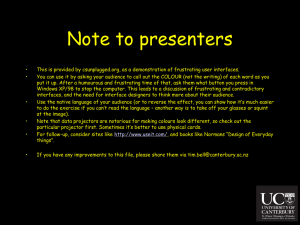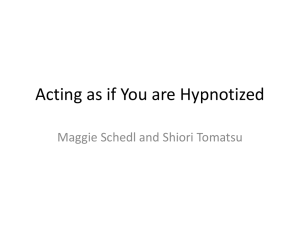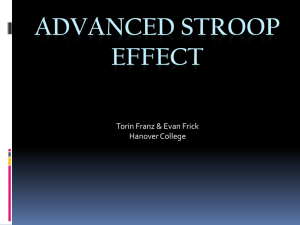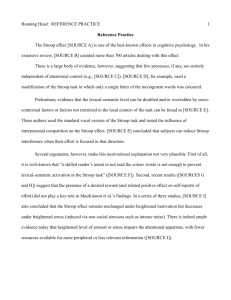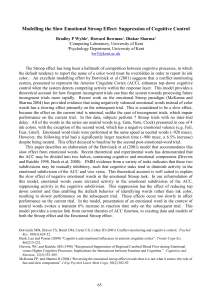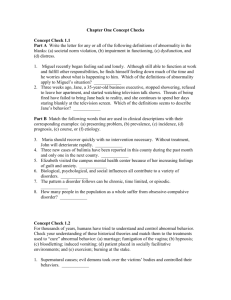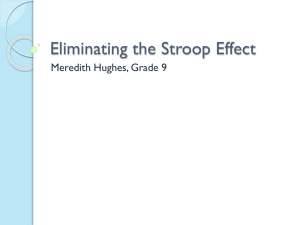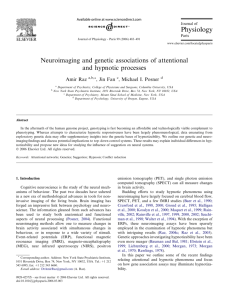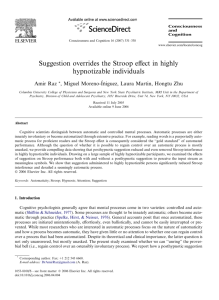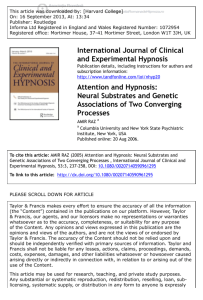Interview with Amir Raz, Ph.D., July 14, 2005 Jane Parsons
advertisement
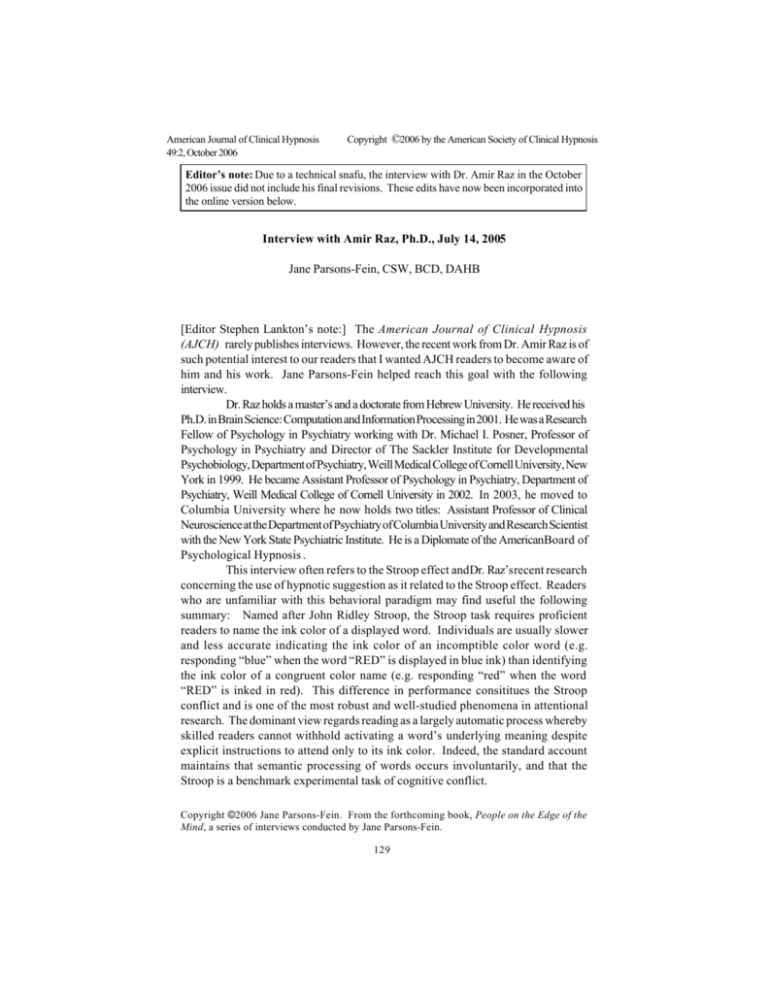
American Journal of Clinical Hypnosis 49:2, October 2006 Copyright ©2006 by the American Society of Clinical Hypnosis Editor’s note: Due to a technical snafu, the interview with Dr. Amir Raz in the October 2006 issue did not include his final revisions. These edits have now been incorporated into the online version below. Interview with Amir Raz, Ph.D., July 14, 2005 Jane Parsons-Fein, CSW, BCD, DAHB [Editor Stephen Lankton’s note:] The American Journal of Clinical Hypnosis (AJCH) rarely publishes interviews. However, the recent work from Dr. Amir Raz is of such potential interest to our readers that I wanted AJCH readers to become aware of him and his work. Jane Parsons-Fein helped reach this goal with the following interview. Dr. Raz holds a master’s and a doctorate from Hebrew University. He received his Ph.D. in Brain Science: Computation and Information Processing in 2001. He was a Research Fellow of Psychology in Psychiatry working with Dr. Michael I. Posner, Professor of Psychology in Psychiatry and Director of The Sackler Institute for Developmental Psychobiology, Department of Psychiatry, Weill Medical College of Cornell University, New York in 1999. He became Assistant Professor of Psychology in Psychiatry, Department of Psychiatry, Weill Medical College of Cornell University in 2002. In 2003, he moved to Columbia University where he now holds two titles: Assistant Professor of Clinical Neuroscience at the Department of Psychiatry of Columbia University and Research Scientist with the New York State Psychiatric Institute. He is a Diplomate of the AmericanBoard of Psychological Hypnosis . This interview often refers to the Stroop effect andDr. Raz’s recent research concerning the use of hypnotic suggestion as it related to the Stroop effect. Readers who are unfamiliar with this behavioral paradigm may find useful the following summary: Named after John Ridley Stroop, the Stroop task requires proficient readers to name the ink color of a displayed word. Individuals are usually slower and less accurate indicating the ink color of an incomptible color word (e.g. responding “blue” when the word “RED” is displayed in blue ink) than identifying the ink color of a congruent color name (e.g. responding “red” when the word “RED” is inked in red). This difference in performance consititues the Stroop conflict and is one of the most robust and well-studied phenomena in attentional research. The dominant view regards reading as a largely automatic process whereby skilled readers cannot withhold activating a word’s underlying meaning despite explicit instructions to attend only to its ink color. Indeed, the standard account maintains that semantic processing of words occurs involuntarily, and that the Stroop is a benchmark experimental task of cognitive conflict. Copyright ©2006 Jane Parsons-Fein. From the forthcoming book, People on the Edge of the Mind, a series of interviews conducted by Jane Parsons-Fein. 129 Amir Raz Interview Dr. Raz’s recent research shows how a posthypnotic suggestion to construe words as nonsense strings reduces and even removes the Stroop interference in highly hypnotizable participants (Raz, 2005). The ramifications of the research illustrate interesting relations between hypnosis and attention. Interview by Jane Parsons-Fein At our annual ASCH meeting in 2005, I heard the excitement in Peter Bloom’s description of his visit to the research lab of Amir Raz at the New York State Psychiatric Institute. He described how Raz was interested in communicating his recent findings to clinicians as well as to the scientific community. I knew that his paper on the Stroop conflict in the Proceedings of the National Academy of Sciences (PNAS) had created enormous interest and had been considered an important breakthrough in brain research and hypnosis. (Since this interview took place, Dr. Raz published three more papers on this theme: one in Nature Reviews Neuroscience; one in Psychological Science; and another in Consciousness and Cognition; more papers are in press. Together with his earlier accounts, these reports cover different aspects of his work on this topic.) This contribution bridges research and clinical work. His interest in hypnosis came from his interest in deception, which is also how he became interested in magic. As he described it to me: Whereas magicians, like social psychologists, often employ deception, cognitive psychologists rarely do. I was intrigued by the influence that expectation, suggestion and motivation impart on human behavior and performance. I happened to stumble upon hypnosis from the vantage point of stage hypnosis, and it was striking to me that most of the people who were involved in stage hypnosis knew little about it in terms of what was happening and why it was happening. I started reading about hypnosis not realizing that this was going to become part of my research. But the more I learned about the field, the more I realized that I could actually use my expertise, my skills, and my training in order to unravel and elucidate some of these fascinating behavioral effects. I learned very quickly that when you perform in front of an audience there is a big element of what people think that you are going to do – not so much what you actually do… The combination of my knowledge of computational neuroscience, my training in psychology and my showmanship skills fused together to place me in an attractive position to launch this kind of research. Jane Parsons-Fein (JP): When you look back, what milestones stand out that moved you forward to where you are now? Amir Raz (AR): The most substantial scientific influence on me came from working with Michael Posner. Mike was my post-doctoral advisor at Cornell. He is not just a nice and smart man, he is a giant in the field of cognitive neuroscience. Posner literally shaped the field with his ideas 130 Parsons-Fein and his contributions. It was a humbling, rewarding and gratifying experience to work with Mike Posner for 3-1/2 years. He works unusual hours. He often walks into the office at 4:00 in the morning, and is a productive and effective researcher. I am quite the opposite, certainly in terms of the hours I keep. I would stay in the office until 4:00 in the morning. Mike would walk in, and we would sometimes discuss things over breakfast. For me it was, you know…. JP: Dinner? (Laughter) AR: By the time I came back 5 or 6 hours later I would have his thoughtful comments and another day to work. It was wonderful. I was deeply inspired by him and his ideas, convictions, excellent science and high ethics, and by his ability to instill compelling passion for good science – not just science, but good science – and to do it in an unassuming way. JP: How would you describe his contribution to the field? AR: He basically came up with breakthrough paradigms and insights. JP: What is an example? The World of Attention AR: In the field of attention, Posner devised an influential model dividing the world of attention into different types. He is talking about executive attention, attention to alerting, and attention to orienting. He single-handedly theorized about many of the findings we later obtained with the advent of neuroimaging. In addition, he was one of the major driving forces behind early imaging of cognitive processes. In the early 80s, he was one of the first people to get positive emission tomography (PET) up and running in a cognitive context. Characteristically, he was one of the first people to suggest that genomics may have interesting links to behavioral phenotype. In his pursuit of individual differences, he was one of the first to correlate psychological traits with genes and to correlate neuroimaging data with genetic components. JP: So how can his work and your work help people in general, and clinicians in particular, get a true idea of what hypnosis is and how hypnosis can help them? In some of your articles you talk about how people have such weird ideas about the nature of hypnosis. AR: Right. There is a limit to what one can do about what people think about hypnosis. People are slow to change their opinions even when presented with compelling data. The first step to a successful campaign is to address the educators – to provide information and experimental findings that change the image or the perception of hypnosis. It is important to reach 131 Amir Raz Interview those who are entrusted with the education of the younger generation. They in turn can influence what tomorrow’s community will feel, think and believe about hypnosis. There is a big difference between feeling, believing and knowing. A s a scientist, my job is to put the data out there without any hidden agendas. I just take the quest. The ultimate quest of any scientist is to get to the bottom of a particular mechanism or process. That is what I am trying to do. In general, suggestion is overlooked in psychological science. I think it has a lot to offer. I think that with the advanced technological tools and the clever experimental paradigms we now have, it is possible to tease apart the effects of suggestion, motivation and expectation on performance. Hypnosis and hypnotic suggestion can be helpful to this quest. The Bridge Between Researcher and Clinician JP: In my field, there is a great difference between the styles of thinking of researchers and clinicians, but the way you think could be a bridge between these two disciplines. AR: I hope so. That is part of the reason I am here in a clinical setting. I am a researcher in a hospital environment. Most people around me here are practitioners, including neurologists, psychiatrists, and neuropsychologists. Together we work to bridge the lacuna between the research world and the clinical world. These two worlds are largely disjoint at times. Some, but not all, researchers are divorced from what is happening in the clinician’s world; the same is true for practitioners in the clinical world who may be unaware of relevant research findings. There are many reasons for this state of affairs including issues related to finance, egos, and “turf wars.” These reasons aside, clinicians should converse with the research folks, and the research folks should benefit from the contributions of clinicians. These disparate fields of expertise are complementary. There is so much to be gained from combining forces. Science is likely to benefit if we merge research with clinical findings. JP: Kay Thompson, DDS, once said that hypnotizability scales work in a lab, but not in everyday life. Very often people can achieve things in life that they cannot achieve in the lab. When sufficiently motivated, they can achieve some things even though they are classified as nonhypnotizable. Ecological Validity AR: I agree; motivation is a factor. However, hypnotizability scales are valid and important research tools. Most behavioral research is done in the laboratory because we are trying to control the experimental conditions. But we should keep an open mind and an open eye for ecological validity. Ecological validity is not easy to determine in the 132 Parsons-Fein psychology lab. This is true for psychological studies about memory as well as many other fields. For example, psychologists study how many digits people retain in memory and they write papers which have farreaching conclusions about the limits of human memory. However, to memorize a string of innocuous indifferent digits is very different from memorizing the digits of a pretty girl who just gave you her phone number. You are differently motivated to remember that phone number, and you might recruit different techniques in order to achieve that goal. This difference in motivation may account for at least some of the difference between lab situations and real life. Ecological validity is an important issue. JP: So, you can bring ecological validity into your lab? AR: Yes, and I am constantly thinking about that. I am running a number of studies that examine ecological validity — especially, for example, when it comes to imaging of the living brain. The Stroop Effect JP: Why do you define the Stroop conflict as robust? AR: The reason that the Stroop effect is robust has to do with the fact that it has been around since 1935 and we are today in 2005. It has been studied widely. There are more than 4000 papers on the Stroop alone. A lot of effort and energy have gone into trying to understand what is happening. It is an effect that takes place even if you do not want it to happen. In other words, even when people know about the Stroop effect in advance and are trying to avoid it they can do little about it. It is still going to crop up. JP: It is automatic. AR: Researchers have used the following words for it: “automatic”, “ballistic,” “involuntary,” and “effortless.” And that is not an exhaustive list. In addition, it is indeed robust because we can replicate it in various conditions with different designs. The anterior cingulate cortex (ACC) is a small part of the prefrontal region of the brain, and is part of the limbic system. The limbic system is philogenetically older in terms of evolutionary development. The limbic system is usually associated with emotion and emotional control. The ACC has been the focus of research effort in recent years. It has been shown time and again to be involved in conflictmonitoring, conflict-resolution, cognitive and emotional regulation, and planning and attention. All these tasks engage a network of areas that includes the ACC as a central node. It is important to realize that we do not know everything about the ACC, but we are beginning to unravel its function. One of the paradigms that we like to use in order to probe the ACC is a conflict task. The Stroop is an example of a conflict task in the 133 Amir Raz Interview context of selective attention. Keep in mind that cognitive conflict in the context of psychological experiments in the lab should be contrasted with conflict in the jungle. When we see a tiger, it is a different type of conflict. Stroop conflict is the kind of experimental task that has become a benchmark for cognitive conflict; it is a perfect vehicle to understanding automaticity. The Stroop effect, because it has been around for so long, has been tested so meticulously and because we think that we know a little bit about it, is a great tool to illuminate what is happening during cognitive conflict. In addition to the Stroop task, many people have used other tasks (e.g. the Simon and other cognitive tasks) to illuminate what is happening in the brain when cognitive conflict is involved. When we image the human brain, the ACC typically lights up during Stroop conflict. For example, the word “red” may be inked in blue and your job is to respond to the ink color. We know that because your natural response is to read, you think about red, not about blue. But you have to somehow override that tendency when you perform the Stroop task and respond only to the ink color. Reading words is a deeply ingrained process. It is automatic for people who are proficient readers. That is not something that people can control after so many years of experience with reading. Of course if you are a child and you just started reading 2 weeks ago it is not automatic, but if you are an adult and have spent a good chunk of your adult life reading books, newspapers, street signs and restaurant menus, you are likely to be a highly proficient reader, and you read effortlessly. That means that you are trained to read what is in front of you. So in the Stroop task suddenly we change the rules. Suddenly you have to ignore what you are reading which is hard because we are so highly skilled at reading automatically. Reporting the ink color instead of the color word that you are reading creates conflict and that translates into more errors on incongruent words. It also translates into slower reaction time or a decrease in speed. These two factors – more errors (or less accuracy) and slower reaction time – characterize Stroop interference. They are its hallmarks. JP: What took you to the point of using posthypnotic suggestion to test the Stroop? Are you the first to have done that? AR: Well, it is a long story. First of all the fact that I am the first one to do it is not as compelling as it might sound. I will explain why. Many people, many of my students, for example, come to me and say, “I would like to do this and that” and I say, “That sounds good. Why do you want to do it?” They reply, “Oh, nobody has done it. I am going to be the first one.” That is a poor argument on its own. My response is: “The fact that you are going to be the first one does not mean that it is worth doing. Maybe you are going to be the first one because people have thought about it and decided it is not worth doing. The fact that nobody has done it does not mean much. However, if it does mean something and you are going to be the first one to do it, first you have to convince me that it is exciting and that it is going to illuminate something new. It is going to elucidate mechanisms, or otherwise advance our knowledge.” 134 Parsons-Fein In the case of the Stroop, I noticed that most of the studies looking at the effect of hypnotic suggestion in Stroop interference before me left something to be desired; the studies had specific methodological weaknesses. Perhaps this was so because they were old studies or perhaps the people who conducted these studies were not sophisticated experimenters. But I was also motivated by my enduring interest in attentional networks. Just prior to my embarking on this study, Mike Posner and I, together with a few other colleagues at The Sackler Institute at Cornell, came out with a paper that described how we can simultaneously measure different attentional networks. These disparate attentional networks are largely orthogonal, we suspected. We have since revised our account a little, but we still think as we thought then, that they are relatively independent. However, there are subtle interactions between them. They are not independent in a formal sense, but they are functionally independent, or, as I prefer to label them, functionally orthogonal. Orthogonal is a mathematical term used in linear algebra to describe lines that do not intersect without being parallel. That is how I think of these attentional networks: they are orthogonal. It does not mean that they do not interact. It just means that they are relatively autonomous and contained. Three Attentional Networks This thinking is important because it was the first time we realized we could influence one such network without having any effect on the others. We have been able to identify at least three attentional control networks: executive, orienting, and alerting. There might be more, but we have not been able to identify them. This is the work of Mike Posner. For many years, he has been saying that attention is not a monolithic singular thing, but that there are many different types of attention. What most people in hypnosis say is that hypnosis is a form of attentive receptive concentration or focused attention, but they do not specifically say what type of attention, perhaps because they look at attention as a monolithic concept. Following William James, Posner was able to point out that attention is not a singular term; different types of attention do different things. Together with Mike Posner and other people at The Sackler Institute, we were able to further identify, characterize, and refine the characteristics of these attentional networks. One of the natural questions that arose, at least in my mind, was: Can we take these allegedly independent networks and squash or enhance their efficiency? I decided to employ a posthypnotic suggestion, rather than hypnotic suggestion, because it is experimentally cleaner. I wanted to know what the relationship was between hypnosis and attention. Most people interested in hypnosis are less familiar with the attentional literature. Even when they talk about attention, they typically refer to it in general terms. They are not always aware of the neural substrates that subserve attention or the various theories of attention. That is where I wanted to step in and make a contribution. Attention is a field that has been a central theme in psychological science for well over 100 years. Today, we speak of attentional subsystems. This kind of refinement is common in science. For example, take fire. What 135 Amir Raz Interview did people know about fire 1000 years ago? Probably not a whole lot! Well, they knew that with fire you can warm yourself up and burn things. But they did not know plasma physics. Physicists can tell us something about fire. You can talk about fire through fireflies and through polar lights and through phosphorescence, but at the end of the day, fire is a pretty complicated physical phenomenon. If you want to know about it, you need to know a great deal. However, the fireman who is running to put out a fire does not need to know all these things. When your watch breaks down you take it to a watchmaker who can fix it. When you need someone to talk to about time you do not go to a watchmaker, you go to a philosopher or to a physicist — to someone who is knowledgeable about the concept of time. The fact that the watchmaker can fix watches does not make him an expert on time. Although he deals with timepieces, devicesthat measure time, he is no expert on time. I felt the same way about hypnosis. Although hypnosis taps attention from a clinical standpoint, the people who practice hypnosis often know little about attention. It was my intention to use hypnosis as a vehicle to elucidate attention. The Stroop Effect and Erickson: No Clear Match JP: Earlier you said, “suggestion is overlooked in psychological science.” I’m wondering if the effectiveness of Erickson’s suggestions in his word-scramble (confusion) technique is comparable to the effectiveness of the confusing (conflicting) suggestions used in the Stroop. In short, is there a relationship between the Stroop effect and our clinical use of confusion techniques? AR: One of the main messages of my research with hypnosis concerns the deautomatization of behavior. I think that what my research shows, first and foremost, is that carefully-formed suggestions, crafted and tailored properly, can influence focal brain activations. That much is shown clearly in my recent PNAS paper. The extension of that result within the Stroop paradigm to the clinical realm at large is perhaps a bit of an overreach. I can see the connections, but at this point, the link would probably be a bit tenuous. Milton Erickson was a brilliant clinician and he was certainly an innovator and a person who had a lot of interesting ideas and successes with treating his patients. He was both versatile and flexible. He did many things. He used metaphors. He was also a person who with his Arizona and Wisconsin background knew the common folks. Much more could be said about Erickson’s important contributions. However, I cannot comfortably say that my results and findings go hand-in-hand with Milton Erickson’s work. JP: I am not saying that either. I am just curious. AR: I can definitely say that there are some interesting parallels and they should be explored further. It is going to be hard to do scientifically, 136 Parsons-Fein but certainly in an exploratory way, in some kind of a preliminary way, my work is a step in that direction. Deautomatization JP: In terms of the Stroop, you have done research with vision and with ADHD. What can be the most helpful to people who are sitting across from their patients/subjects all day long? It really helps us to have some idea of what is happening in the brain as our subject shifts from one state to another. AR: One of the main messages of my research addresses a multiproblem approach. I do things that are not hypnosis-related. But the common thread is in deautomatizing deeply ingrained processes. As we grow up in the world, mental processes fall into one of two categories: either they are voluntary (i.e., controlled) or they are involuntary (i.e., automatic). Reading is a good example of an automatic process. After we master reading and we practice it time and again, it becomes automatic. Driving is another such activity. When we start driving it is not very automatic, but after we drive for a few years and we commute every day back and forth to our work, driving becomes automatic. So automatic, as a matter of fact, that we often shift into “auto-pilot” mode and pay little attention to how we get from one familiar location to another. What my research findings suggest is that hypnosis can deautomatize certain processes for some people. The ability to deautomatize an automatic process is big news because if you can take a person who can read and make her unlearn the reading, that says something about the ability of the brain, or higher brain functions, to override and exert top-down control over other brain regions that are probably responsible for the practiced event. And that may imply that we can take habitual behavior, or all kinds of behavioral patterns, and potentially modify them. JP: Is what occurs a form of awareness? AR: Well, you know when you start talking about awareness and about [attention]… JP: I know they are different… AR: It gets tricky. In this study, for example, I did not have to invoke the concept of awareness. It was straightforward and it worked beautifully. JP: Which study, the deautomatizing one? AR: Yep! Highly susceptible participants were convinced that what they saw was in a language that they did not know and… JP: So it was just a posthypnotic suggestion? 137 Amir Raz Interview AR: That was just a posthypnotic suggestion. JP: So your findings could be very exciting to clinicians who track unconscious programming (imprinting) in families. Their goal, after all is to deautomatize the habitual, posttraumatic response that patients have absorbed from their families over time. AR: Absolutely! I think it has tremendous potential. I think that this research informs the clinical field because of the deautomatization aspect of it, but also because of the power of words and the fact that words can translate into specific influences on focal brain regions, which is news – big news! This work is also important for anyone interested in the placebo effect. The data are compelling, especially if you are interested in expectation and motivation, and in how attention can change perception and regulate cognition, emotion, and action. This is not the first time that this story has been told. People have said many times that attention can change perception. However, this time, drawing on completely objective scientific methods such as eventrelated potentials, fMRI, and behavioral measures, the story is more scientific. The conjunction of these disparate data provides a confluence of factors that we like to see in science: converging evidence... Converging Evidence Converging evidence is key to a good scientific argument. It is great to show behavioral data; it is fine to show functional magnetic resonance imaging data; it is nice when you show event-related potentials from electrical scalp recordings, but when you show all three of them combined in one study with a good experimental design and a well-thought-out paradigm, and you relate your results to more than 70 years of research on this particular paradigm with more than 4000 papers written on it, that is what makes this piece different. It is why it was able to get the kind of coverage it did, and make the kind of splash it did. JP: Can you define again the difference between attention and awareness? AR: That is a hard call. There certainly is a very tight coupling between attention and awareness. Can you be aware of something without paying attention to it? Attention again is NOT a single thing. There are different types of attention. Part of the argument for conscious awareness would be that you need a certain level of activity in these networks in order for something to reach awareness. People have been working and thinking about the relationship between attention and awareness for many years. It is not a new thing. But personally I think that such discussion is not as productive as I would like it to be because I find people easily trail off and diverge into 138 Parsons-Fein philosophical arguments, especially when I look at recent papers that try to address these issues. These accounts are often verbose, and they typically lack clarity. My personal view on the relationship between attention and awareness is that attention is an important ingredient in the formation of awareness. It is likely a necessary ingredient, but I am not sure that it is sufficient. JP: How would attention or awareness – or conscious or unconscious – fit into the understanding of neuroimaging and the work that you are doing? AR: I do not know that it does. I think that these are interesting concepts and they might be helpful clinically, but I am not sure I can see a direct relationship between these constructions and the work that I am doing here. Milton Erickson, as influential and as important a figure that he was, did not directly inspire my investigation. I am aware of his work and I am aware of most of his contributions — they are significant and noteworthy. I would not say the work I do is divorced from the Ericksonian approach. But it is a far cry from being able to address these concepts directly. I think the gap between Erickson’s unconscious and anyone else’s unconscious is just too great to bridge with anything but handwaving, and I do not feel comfortable doing that. JP: So it is really the use of language that we are talking about here? AR: It is the use of language to form suggestions that are customtailored to people who are known to be highly hypnotizable at the extreme end of the scale. JP: Known to be defined as high hypnotizables in terms of the particular kinds of testing you are doing. AR: Yes, known to be in terms of the Harvard and Stanford scales. These are the scales that I used here. It does not mean that people who are not highly hypnotizable cannot benefit from suggestion. As a matter of fact I have evidence to the contrary. I have a paper that is currently under review reporting that even less hypnotizable persons can be influenced by suggestion, albeit to a lesser extent and in a different way than highly hypnotizable people. Nonetheless, they are affected. Some people may say that the whole identification or characterization of people into less hypnotizable or highly hypnotizable may be an academic game. But I think that it is a game that needs to be played in order to do things in a rigorous and controlled fashion. If you do not screen participants carefully, experimental data are going to be difficult to interpret. JP: This latest study sounds most exciting in terms of our field. 139 Amir Raz Interview AR: I think that the PNAS study provides compelling evidence. But I actually think my previous papers were probably easier to understand for clinicians because they were less technical and I had more space to expand on my results. Most practitioners who would grab the PNAS paper would find it a bit dense; it is meant for the scientific community. Unfortunately, I think that in terms of the language and the background, few hypnosis clinicians are conversant with neuroimaging. It would make more sense to write a paper that caters to practitioners. JP: The clearer we become the more precise we can become. I know the idea of “unconscious” is a vague term but I also know that as a concept it “works.” AR: When something works, my tendency is not to argue. I would like to try to understand why and how. These are very different questions. JP: How can you translate your work so that clinicians can make better use of it? AR: As a scientist I am trying to answer the question of “how.” How does it work? What is happening? And I am trying to steer clear of the question, “why.” JP: Let us go back to the anterior cingulate cortex and posthypnotic suggestion. What happens in the brain when the person looks at the word “red” and can’t say “blue?” AR: Well, when you have a conflict situation like that, the anterior cingulate cortex lights up. Because that is a central node in the brain that is involved in either monitoring conflict or resolving it. JP: Does the lighting up mean more blood goes to it, or oxygen? AR: It probably means that there is more neural activity in that region. However, what we measure with fMRI is an indirect index of neuronal activity. That means that what we are measuring is how oxygenated the blood is in that region. Thus, it is an indirect index of neuronal activity. JP: So more oxygen goes up to it at that moment? AR: Right! Changes in oxygen alter the magnetic properties of the blood at that point. The brain is biological tissue using electrochemical energy. Neurons generate small amounts of electricity and communicate via chemical signals. Sometimes we are able to measure these processes. With event-related potentials (ERP), when we put on scalp electrodes, we can eavesdrop on these electrophysiological activities. With fMRI, we can indirectly measure metabolic changes. So the ERP is a direct measure; the fMRI is an indirect measure of neural activity Another thing we are 140 Parsons-Fein showing in this image is that there are changes in the occipital region. These are areas that allegedly (again, there is controversy about these areas) may be related to visual word forms. These are areas responsible for interpreting vision stimuli as words, so by showing these kinds of activities we suspect that these people are not reading because their visual word form areas are not engaging. The ERP is a lot more sensitive timewise so the temporal resolution of the ERP is much higher than that of fMRI. fMRI can look at what is changing in the brain within a second or so. ERP can show you what is changing in the brain at the millisecond resolution: millisecond after millisecond. What I was able to do was to combine ERP with fMRI, which looks at what is changing in the brain with a one-millimeter resolution spatially. fMRI has excellent resolution in space and ERP has excellent resolution in time. So if I combine both of them I get the best of both worlds. I get the millisecond resolution from the ERP; I get the onemillimeter spatial resolution from the fMRI. Putting it together I have a nice, cogent story that I can tell. And my story shows that the first thing that is happening is that there are changes in the occipital region—there are changes in the way people see the world. Highly suggestible individuals following the posthypnotic suggestion seem to see the world differently and their ACC does not respond to conflict the way it does when posthypnotic suggestion is not engaged. The data show that 150 milliseconds after the Stroop word appears there is already change in the way that the brain processes the information under posthypnotic suggestion relative to when there is no suggestion (i.e., when suggestion is absent). As a result of that early change in visual processing there is also altered ACC activity. That means that first they see the world differently or, if you want, they see the words differently, and later the ACC does not detect conflict in the input stream. These are pretty amazing results because they suggest to me that people are capable of deautomatizing a process as ballistic and as involuntary as reading. Deautomatization may be extended and generalized to apply to other kinds of habitual behavior. If we could do that it would be important news to the clinical community. Trajectories JP: What is your vision of how this can be important news to the clinical community? What is the trajectory here? AR: The trajectory, first of all, is to try to understand a little bit better the difference between highly hypnotizable persons and less hypnotizable people. The other direction to take is to see if we can harness these particular results to clinical populations. My first choice would be impulse control disorders. Because in impulse control disorders people are trying to fight a particular urge that they have. If I can deautomatize an urge (e.g., a tic in a Tourette’s syndrome patient or binge eating in people diagnosed with eating disorders such as bulimia, where we know patients are likely highly hypnotizable) that would be exciting and the clinical value should become evident. If we can find a good clinical population to extend the 141 Amir Raz Interview Stroop study further then I could perhaps compellingly demonstrate the applied deautomatization of certain habitual patterns. That would make me happy because I would be able to take my research from the theoretical scientific domain and extend it to the clinical domain and actually be able to help people, which is what I want to do. JP: With regard to theories of hypnosis, in my field there always is a question whether it is trait, whether it is state, whether it is socially driven or whether it does not exist at all. AR: I think that rather than being helpful at least some of the tentative ‘answers’ to these questions have instigated unnecessary tension within as well as between both clinicians and researchers. I believe that these questions can be marginalized as they are largely irrelevant to doing good research and advancing the field. Clearly, there might be an element of social compliance and there might be the possibility of state. I just do not see why these things are important enough to paralyze a whole community. JP: Thank you for the wonderful work you are doing that certainly has contributed to our understanding. References Raz, A. , Fan, J. & Posner, M. I. (2005). Hypnotic suggestion reduces conflict in the human brain. Proceedings of the National Academy of Sciences, 102, 9978-9983. Stroop, J. R. (1935). Studies of interference in serial verbal reactions. Journal of Experimental Psychology, 12, 643-662. 142
